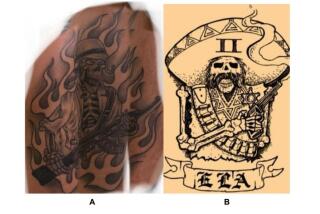L.A. sheriff watchdogs alarmed about new claims of secret deputy clique at Compton station
- Share via
Some members of a Los Angeles County watchdog panel are calling on Sheriff Jim McDonnell to launch a thorough investigation into allegations of a secret society of deputies that brands its members with matching skull tattoos.
The revelation this week that a deputy admitted to getting inked two years ago as part of a ritual within the Compton station has raised concerns that deputy cliques, long part of a controversial agency subculture, have persisted despite the department’s reform efforts.
Hernán Vera, who serves on the Sheriff Civilian Oversight Commission, said the deputy’s admission in a lawsuit over a fatal shooting that he and as many as 20 others have the signature tattoos was “thoroughly disturbing.”
“It’s not the kind of culture that you want to foster in the 21st century Sheriff’s Department,” said Vera, a principal in the law firm Bird Marella.
McDonnell said that for the last year, the department has been examining deputy tattoos, logos and symbolism within the organization, but he hasn’t launched a new investigation into the Compton station deputies.
He said there is also a separate administrative investigation into the shooting, which may address the deputy’s admissions.
“I’m not somebody from a generation where tattoos are accepted the way they are today,” said McDonnell, who said he was unhappy when he found out a couple of weeks ago about the deputy’s admissions under oath. “I’m looking at what’s behind it. Is it just body art? … Is it something that reflects well on our core values?”
The department has a long history of clandestine groups — with names like the Regulators, Grim Reapers and Jump Out Boys — that have been accused of promoting highly aggressive tactics and perpetuating a code of silence among members. Nearly 30 years ago, a federal judge said the Vikings club was a “neo-Nazi, white supremacist gang.”
Some deputies see the groups as more benign and believe the notoriously violent cliques are outliers. To these deputies, getting a matching tattoo is more a sign of camaraderie in a potentially dangerous profession — a symbol of pride in being a fearless, proactive officer or surviving a near-death experience on the job.
The latest revelations, detailed this week by The Times, center on a deposition given in May by Deputy Samuel Aldama, who described under oath a tattoo on his calf featuring a skull in a military-style helmet bearing the letters “CPT” for Compton, along with a rifle, encircled by flames.
He said he got the tattoo in June 2016, about two months before he was involved in the fatal shooting of Donta Taylor.
Aldama, who was testifying in a lawsuit brought by Taylor’s family, said 10 to 20 other deputies had the tattoos, but he denied they were part of a clique, according to excerpts of the deposition reviewed by The Times. He said “working hard” on the job — making arrests, responding to calls — was the only requirement for getting the tattoo.
An attorney representing the family has said the shooting of Taylor, who was black, was racially motivated. The lawyer, John Sweeney, asked Aldama in the deposition whether he harbored any “ill feelings” toward blacks in general. After a long pause, Aldama replied, “I do, sir.” The deputy later said he didn’t have any ill feelings and that he had misunderstood the question.
At a news conference Friday, Sweeney noted that he is representing another black client who alleges in a lawsuit that he was seriously beaten by Aldama and his partner in a racially motivated attack in January 2016. “We know that this is a violent clique,” Sweeney said.
In August 2016, Aldama was with his partner, Deputy Mizrain Orrego, when the pair opened fire on Taylor after a nighttime foot pursuit. An autopsy showed Taylor had been shot six times.
Deputies alleged Taylor was wearing gang attire and pointed a gun at one of them immediately before the lawmen opened fire, according to a district attorney’s report summarizing what happened. Despite an extensive search, no weapon was found. Sheriff’s officials said tests on Taylor’s pockets and waistband turned up gunshot residue that was consistent with a handgun.
After reviewing the shooting, the district attorney’s office concluded the deputies acted reasonably.
Priscilla Ocen, a Loyola Law School professor who also sits on the Civilian Oversight Commission, said the use of a skull tattoo celebrates violence, raising concerns that deputies might be more willing to engage in brutality on the streets.
“You have law enforcement, which routinely uses labels like ‘gang member’ to justify certain kinds of policing and to excuse deadly force. Meanwhile you have allegations of a gang operating out of the Sheriff’s Department. I think that’s deeply troubling,” Ocen said.
Compton station Capt. Michael Thatcher said Aldama has been removed from patrol but remains at the station. Orrego, he said, was fired in an unrelated case. Thatcher declined to say why.
Efforts to reach the deputies were unsuccessful. Harold Becks, a lawyer representing the Sheriff’s Department in the Taylor lawsuit, did not respond to a request for comment.
Thatcher said he learned of the existence of the tattoo a few weeks ago. Afterward, he sent an email to his staff alerting them that while he doesn’t have any tattoos, those who do should be able to explain why they got one and to understand the tattoo’s history.
“This might also be necessary if you wish to someday work an assignment where the origin and meaning of tattoos might be scrutinized,” Thatcher wrote, according to a copy of his June 8 email reviewed by The Times.
Thatcher said he was concerned and curious about Aldama’s statements and that he doesn’t know whether the deputies with the tattoo are part of a group that has a name.
“I don’t believe that the existence of this tattoo has contributed to anything that would cause me concern,” Thatcher told The Times.
McDonnell said in a statement that the recent revelation about the Compton tattoo “does not in any way reflect the LASD of today.”
“Compton station exhibits all of the key indicators we look for in successful community policing,” he said, noting that arrests from the station are up 41% over the last two years while shootings by deputies have dropped 33% over the same period.
He added that deputies act as mentors and tutors for children in the Compton Youth Activity League.
Robert Bonner, a former federal judge who is chairman of the Sheriff Civilian Oversight Commission, said previous investigations have shown some deputy groups can be harmful.
Bonner was a member of the Citizens’ Commission on Jail Violence, which in 2012 condemned the cliques and matching tattoos, saying they undermined camaraderie among deputies as a whole and that the department’s tolerance of the groups contributed to abuse of inmates in the jails. McDonnell was also part of that commission.
Bonner said he expects the oversight group will look into the tattoo controversy.
“These cliques, which have often involved identifying tattoos, should not be tolerated,” Bonner said. “They undermine supervision and in the past led to use of excessive force.”
Twitter: @mayalau
UPDATES:
2:55 p.m.: This article was updated with details from a news conference by attorneys representing Taylor’s family as well as background about deputy tattoos.
This article was originally published at 5 a.m.
More to Read
Sign up for Essential California
The most important California stories and recommendations in your inbox every morning.
You may occasionally receive promotional content from the Los Angeles Times.











